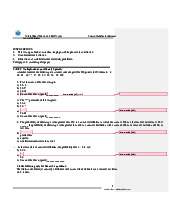

Preview text:
Prepare by Trịnh Ng c ọ Nhân I) Key concept:
- Statistics is the science of collecting, organizing, analyzing, interpreting and presenting data. - A statistic i
s a single measure, reported as a number, used to summarize a sample data set
Example: The average number of points earned by students in that one math class at the end of the course
- Descriptive statistics (th ng kê m ố
ô tả): mô tả ngắn g n hay tóm ọ tắt m t ộ tập d ữ liệu nhất
định, có thể là đại diện cho toàn bộ ặ
ho c một mẫu của một tổng thể
- Inferential statistics (th ng kê suy lu ố ận): quá trình suy lu m
ận suy ra các đặc điể của một
phân phối cơ bản bằng việc phân tích dữ liệu
-> Để dễ dàng phân biệt thì các bạn nhớ cho mình tips nhé: Từ phân tích lớn -> bé được gọi
là thống kê mô t (
ả descriptive statistics) và ngược l i
ạ , từ phân tích cái bé -> cái lớn thì g i ọ l ạ
thống kê suy luận (inferential statistics).
- Empirical data: data collected from observation and experiments.
II) Some practice exercises
Question 1: A recent study of 231,164 New Jersey heart attack patients showed that those
admitted on a weekday had a 12.0 percent death rate in the next three years, compared with
12.9 percent for those admitted on a weekend. This difference was statistically significant.
“That’s too small to have any practical importance,” said Sarah. Do you agree with Sarah’s conclusion? Explain.
Question 2: A statistical consultant was retained by a linen supplier to analyze a survey of
hospital purchasing managers. After looking at the data, she realized that the survey had
missed several key geographic areas and included some that were outside the target region.
Some survey questions were ambiguous. Some respondents failed to answer all the questions
or gave silly replies (one manager said he worked 40 hours a day). Of the 1,000 surveys
mailed, only 80 were returned.
(a) What alternatives are available to the statistician?
(b) Might an imperfect analysis be better than none?
Question 3: Analysis of 1,064 deaths of famous popular musicians showed that 31 percent
were related to alcohol or drug abuse. “But that is just a sample. It proves nothing,” said
Hannah. Do you agree with Hannah’s conclusion? Explain.
Question 4: “Lacrosse helmets are not needed,” said Tom. “None of the guys on my team have ever had head
injuries.” Is there a fallacy in Tom’s reasoning? Explain.
Question 5: A research study showed that 7 percent of “A” students smoke, while nearly 50
percent of “D” students do. Prepare by Trịnh Ng c ọ Nhân
(a) List in rank order six factors that you think affect grades. Is smoking on your list?
(b) If smoking is not a likely cause of poor grades, can you suggest reasons why these results were observed?
(c) Assuming these statistics are correct, would “D” students who give up smoking improve their grades? Why or why not?
(Solution các bạn có thể tra sách nhé ^^)
III) Other reading material
- Statistic in the real world: https://www.youtube.com/watch?v=eoF_dIpyeBo
- Application of Statistics in daily life: https://www.youtube.com/watch?v=HUThHJ6E3rY
- Descriptive and Inferential data: https://www.youtube.com/watch?v=VHYOuWu9jQI




